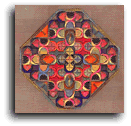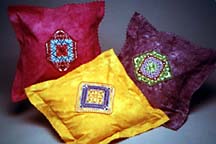 |
||||||||||
| Dyed and Gone to Heaven – An Online Magazine and Needlework Resource |
|
||||||||||||
|
 |
Orna Willis
By Rita Vainius
Click here for her FREE PATTERN 
"By just letting shapes talk, you can create beautiful things."Orna Willis understands the language of shape and of color as well. She explains how the artistic process unfolds: "If you squint your eyes when looking at the world, you see it built of shapes and colors. My aim is not to give a realistic impression. After all, the real stuff is there for all to look at. I want to give my own spin on it." Her perception and interpretation of what she sees stems from this singular perspective. Orna can take anything, whether living or inanimate, and break it down into a geometric pattern. This transfiguration, coupled with her stunning use of uncommon color combinations, accounts for the extraordinary appeal of her work to needleworkers ever on a quest for something new and different.
Orna's roots in two autonomous cultures, American and Israeli, are abundantly reflected throughout her work. Her father moved the family from Israel to the San Francisco Bay Area when Orna was 3. Life was good and they all prospered. Until one day in the 60's, when Orna's mother saw her teenage daughter returning from school in torn bell-bottoms, a too-close-for-comfort resemblance to the hippies who were making daily headline news. Since her parents had intended to return to Israel, it seemed the right time to do so. None too soon, as Orna's vivid imagination and zest for experimentation had already lured toward the counterculture.
Though art was always a part of Orna's upbringing, her formal artistic education began in Israel. The nation encompassed peoples from a myriad of ethnic backgrounds and this blending of cultures resulted in new art forms which Orna studied and incorporated into her pursuits in pottery, apparel, decor and painting. After completing school, her talents led to some freelance interior design work, but, as a single mother, Orna could not afford to pursue a career in art exclusively. When her daughter, Shiri was 11, Orna moved back to the U.S. to give Shiri the exposure to another culture which had so enriched her own life. They settled in the Bay area and Orna took a job with a computer firm and later with the Israeli consulate. While teaching Hebrew classes at a local synagogue, Orna met Reid Willis, her husband-to-be. When Reid, a scientist and patent agent, was offered a job in Michigan, the family moved there.
For the first time in her adult life, Orna had time and resources to devote to artistic pursuits. A friend, Dena, introduced her to needlepoint and upon spying the array of fibers available, Orna's fingers began to itch in anticipation. She bought a canvas, but after only 2 projects, began envisioning taking ethnic influences from her own life and bringing them up to date in needlepoint. Thus propelled, she chose threads, "writing a check that made my hand shake." Within a short time, Orna was inundated by experiments carried out on bits of canvas - it was time to do something with them. She began incorporating the designs with tie-dyed fabrics into pillows.

When she discovered UtraSuede, it was a bonanza as the rich, velvety texture and depth of color complemented her work in an especially dramatic way. She found that adding her designs to handbags and totes also created a happy marriage of art and function. When venturing out, striking bags in hand, people took notice. One of the first to show an interest was a woman who invited Orna to have a show in her gallery. It was an experience Orna describes as both strange and wonderful. Wonderful, because it was a thrill to be recognized professionally and strange, because displaying your creative output is like putting a real part of yourself on view for others to scrutinize, discuss and appraise. She recalls it as an "almost out-of-body" experience.
.
While on a trip to Baltimore, Orna stopped into a knitting shop where the owner went nuts for the bag Orna was toting and requested one for herself. This got Orna started on breaking down her design into its individual components. It is her strong belief that any design, no matter how artistic or detailed, can be presented in such a way that any beginning to intermediate stitcher can complete it. She then sent some of her designs to Rainbow Gallery. They bought 3 charts and suggested that she contact wholesaler Sharon Hooper at Sharon's Designer Collection. Sharon agreed to carry Orna's designs and has been selling them to retailers ever since.
Still a big proponent of form and function, Orna continues to find novel way to apply her designs. Her aim is to explore beyond the norm in needlepoint, looking at the possibilities for design adaptations that are unconventional. One result is a mobile composed of double-sided, 3-dimensional stitched pieces, embellished with beads, which are then suspended from curved segments of copper pipe. Incorporating Middle Eastern influences, one can readily envision this needleart sculpture dangling inside a Moroccan tent. Though she still enjoys painting and ceramics, Orna's free time is constantly dwindling. Her solution is to combine her other interests with her design work, as in embellishing a table runner with her own handmade polymer clay beads.
In designing kits for her designs, Orna placed much emphasis on combining graphic beauty with a sense of fun in the presentation to get the stitcher's creative juices flowing and give added incentive to complete the project. Besides including canvas, fibers, detailed instructions, and pre-cut UltraSuede, the kits feature a specially laminated chart on which stitchers can make their own notations and the chart itself is printed in color, becoming a work of art on its own. Orna's reasoning was: "My intention was that when you open one of my kits, you are immediately drawn into the art itself. I want people to feel the same tingling I felt when I walked into that needlework store for the first time."Orna has even improved on this by enclosing everything in an attractive and durable polystyrene envelope with tie closure, making each kit easily transportable in its own reusable container.
Middle Eastern pottery, fabrics, mosaics, tiles and symbols, a vast library of designer books and her stunning collection of blown glass art pieces provide plentiful design inspiration. Color remains an endlessly intriguing element. She revels in the challenge of taking two colors which are the least compatible together and finding the "missing link" which will combine them in an aesthetically compelling way. The Caron threads, with their endless array of colors, textures and variegations have been enormously influential. In designing, Orna proceeds from mental imagery directly to canvas. She finds it impossible to use intermediary steps of any kind, but experience has taught her to trust the process, "When I'm flowing with a piece, it just feels right - my insides are nodding as I work."
Although a relative newcomer to needlepoint design, Orna has already made an impact. In the Jan.1999 issue of Stitchery Magazine, Orna's life, designs and exclusive pattern, Lori, were featured. Reader response was so positive that in July they spotlighted her design, Shabbat Shalom. Orna is scheduled to appear and demonstrate a project on the Carol Duvall Show (Home and Garden Channel) which will be aired in mid December. For this she has designed Mosaic Inspirations, stitched with Caron variegated threads. Orna's goal is to appeal to and inspire a non-stitching audience that is unaware of the tremendous potential for creativity and self expression using threads. She points out the many possible applications for this design: it can be used singly to make a curtain tie-back, makeup case clasp, shade pull or compact mirror case; two hanging in tandem can create a tiered ornament; several, stitched in different color combinations and combined, can transform a checkbook cover, pillow or bag or be fashioned into a needleart mobile.
Beginning with the New Year is a cyberworkshop which Orna will be teaching for the ANG. Her teaching project, Jerusalem 2000, commemorates its designation as "The City of the Millenium." Her design emphasizes the special beauty and pride of place where 3 of the world's major religions co-exist within its fabled walls. Orna's continued goal for the future entails using the patterns, techniques and other elements found in traditional needlework and updating and refining them to contemporary lifestyles and tastes - striving for a distinctive, unusual and yet harmonious blending of old and new, allowing the best of both to shine through.
Though not a fashion plate or follower of fads, Orna admits to the necessity of keeping up with decorative trends. With the recent popularity of insect motifs in fashion, jewelry and home accessories, Orna has also turned her attention to entomology themes. A recent influence on Orna's work since moving to Michigan has been Shaker style. The Shaker philosophy is based on an intuitive color sense and the integrity of shape, devoid of any extraneous intricacy of detail. Shaker pieces are composed of simple lines, projecting an understated elegance which speaks of a beauty born of practicality. A design approach very similar to Orna's method of "just letting shapes talk."
Orna's designs, sold under the name, Ornaments - Designs by Orna, are carried by most needlework shops. For a shop near you, call Sharon's Designer Collection at 1-800-925-9944.
For more information about Orna's designs or to inquire about finished items, write to her at 1906 Wood Parke Ln, Commerce, MI 48382 or e mail her at OrnaW@aol.com.